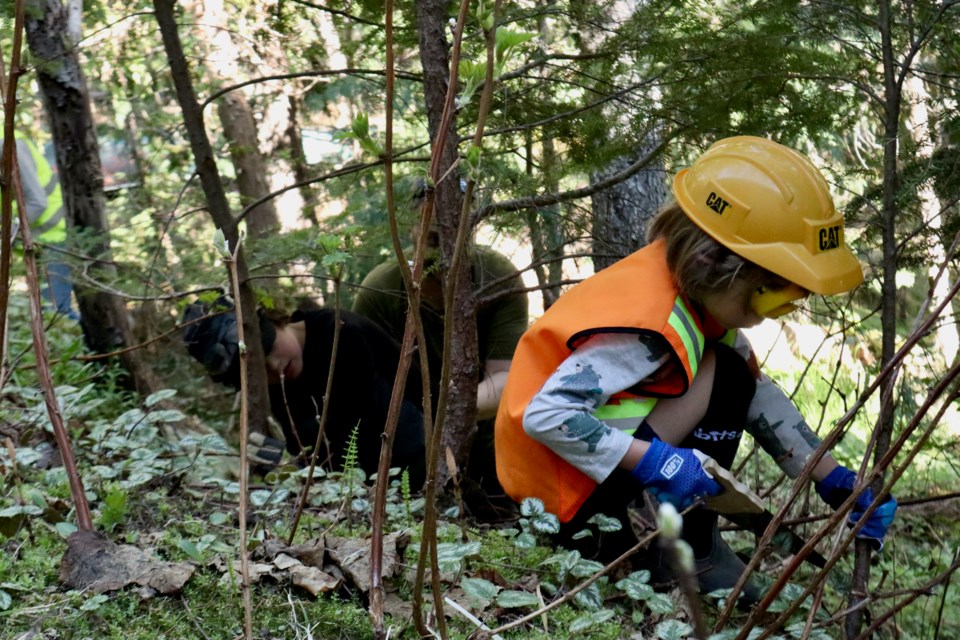On a hot Saturday in May, community members of all ages in Whistler broke out their handsaws and rakes, rolled up their sleeves, and started landscaping their properties. It wasn’t an average day of gardening, though—they are trying to protect their neighbourhoods against wildfires.
When a wildfire inevitably encroaches on homes this summer in B.C., one of the best defences is having a FireSmart home.
The FireSmart program makes it less likely a fire will spread from the ground or through embers in the air to a property, through mitigation efforts that include removing fuel. Removing the lower branches of trees helps prevent a fire moving into the canopy and to the roof, while landscaping efforts like wildfire-resistant plants, trimming grass and weeds and cleaning gutters and under decks, are some of the many tools homeowners can employ to protect their land.
Millar’s Ridge and Rimrock Estates residents in Whistler recently took up the FireSmart assessment process, and gathered with FireSmart coordinator Scott Rogers and other representatives to receive FireSmart Canada Neighbourhood Recognition signs May 11.
The signage recognizes the neighbourhoods have had property assessments to reduce loss in the event of a fire, and have created a community group which maintains a FireSmart focus over time. After getting their signs, each neighbourhood got to work removing fuel for fires.
There are now 26 neighbourhoods in Whistler that have received the designation.
Emma Keely lives in West Vancouver and shares a property in Rimrock. Her family came to take part in the event so they can learn practical ways to help in the community and connect with neighbours.
“This is a way we can actually, you know, come in, use our hands and participate versus worrying and not being able to help, I guess,” she said. “I think some of these things, particularly around climate change, seem really big. The individual I think often is a bit lost in terms of what it is you can do day to day to help, so in my view, we’re trying to do our part.
Climate change and wildfires
The River Forecast Centre’s Snow and Water Supply Bulletin from May 1 showed the provincial average for snowpack is “extremely low.” For comparison, last year’s snowpack was 91 per cent of average. The lower snowpack is leading to smaller freshet flood hazard in most areas within B.C. However, the small freshet is combining with warm weather and an on-going drought, “creating significantly elevated drought hazards for this upcoming spring and summer,” the report said.
Environment and Climate Change Canada’s temperature forecast for May, June and July expects warmer than average temperatures throughout Canada.
With a hot and dry summer ahead, wildfires are already impacting communities close to home. Properties in the Squamish-Lillooet Regional District’s Area A on an evacuation alert, with the 100-hectare Truax Creek fire deemed out-of-control.
Rogers explained FireSmarting in advance is especially important when a wildfire does encroach on a property, because response agencies have to account for how dangerous conditions are.
“What response agencies are able to do is entirely dependent on the conditions, the timelines and the resources that are available to address the needs,” he said. “And so resource allocation will reflect what’s safe and appropriate for the responders to do at that time.”
FireSmart properties are also more likely to survive, so protecting them takes precedence over properties that aren’t.
“We’re making it more likely that the triaging includes the properties that have already initiated the mitigation ahead of time,” Rogers said.
“So yeah, what we’re doing here is furthering likelihood of property survivability on quite a number of different levels.”
Insurance troubles
Getting fire insurance for properties is proving difficult as wildfires increase the risks for insurers, according to Rogers.
“We’re seeing the insurance industry change as expected in the face of increasing wildfire around the world,” he said.
FireSmarting could become a precondition to receiving fire insurance in coming years, he added.
Getting an insurance policy or changing a policy when there are existing wildfire threats is also problematic.
The Insurance Bureau of Canada’s website highlights “temporary restrictions or limitations on the sale of new coverage” when an area is under threat from wildfire.
With last year’s record-breaking wildfire season, people are more aware than ever their actions can make the difference when a wildfire sweeps through, and Rogers said right now is the best time to start taking precautions.
“The best time to do this kind of stuff is right now and the trend is for longer, hotter, drier summers. A forest is fuel when it's dry—people are very aware of last year's impact. And you know, these days it's about how to learn to live with wildfire. I think people are opening their minds to that…We all have a role to play.”




